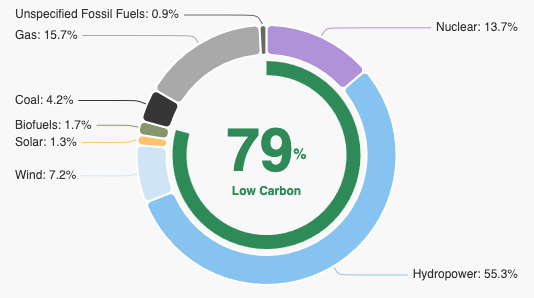Live EV/ICE Emissions & Cost Comparison
Canada's Electricity Production
Explanation / Details / Sources
For Alberta: The pie chart above is a real-time graphical representation of Alberta’s power generation sources. The data is sourced from the Alberta Electric System Operator (AESO). Because Alberta has many sources of power it is difficult to determine how much GHGs are emitted per kWh of electrical energy created. This built in calculator and drop down menu system is an easy tool for estimating the GHG emissions from an electric vehicle on Alberta’s grid and also allows you to make quick comparisons to many Internal Combustion Engine vehicles.
Alberta AESO Current Supply Demand Report:
ets.aeso.ca
For other provinces: Data is gathered from historic publicly accessible information. Click on the Historical Data button below the pie chart for specific sources.
Electricity Fuel Emissions Source Data:
-Fuel consumption values are sourced from Natural Resources Canada
-1 litre of gasoline emits 2.44kg CO2e
-1 kWh produced by 100% Coal emits 0.909kg of CO2e
-1kWh produced by 100% Natural Gas emits 0.465kg of CO2e
-1kWh produced by 100% Renewables emits 0.000kg of CO2e
-1kWh produced by 100% Biomass emits 1.5kg of CO2e
-1kWh produced by 100% Diesel Generator emits 0.75kg of CO2e
The figures above are representative of typical emissions. As such their accuracy will vary from province to province however the error margin is small. We are forever open to improving the veracity of the inputs to the tool so if you have better sources for the inputs please email us at [email protected]
Some notes about the calculator:
-The tool currently only works for Battery Electric Vehicles (BEV) and does not work for Plug-In Hybrid Electric Vehicles (PHEV)
-Our thanks to Dr Hesam Yazdanpanahi for the inspiration to make this tool
-Prior to 2014 Alberta’s electricity sector accounted for 16% of the provinces GHG emissions. In 2016 the Government of Alberta announced the Climate Leadership Plan which aims to entirely shift away from coal as a fuel for power generation by 2030. It is also planned to have at least 30% of the provinces overall energy coming from renewable sources by 2030. For the first time in decades, in 2018, the province was able to achieve less than 50% of its energy needs from non-coal sources. This tool will be here every step of the way.
